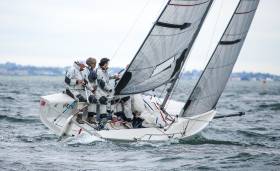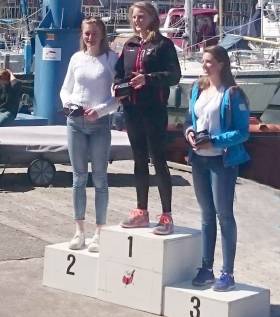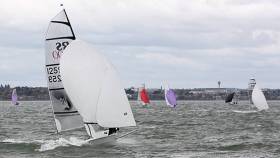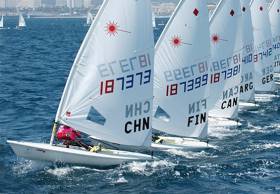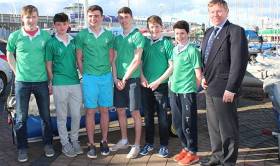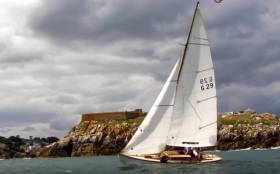Displaying items by tag: Royal St George Yacht Club
O'Leary Extends 1720 Euros Lead at Royal St.George
Royal Cork YC's Anthony O'Leary continues his lead of the 17–boat 1720 European Championships on Dublin Bay. O'Leary now has a margin of three points after scoring three seconds in races four, five and six today. Defending champion Neil Hogan stays second on 12 points. Third overall is Baltimore Sailing Club's Ben Cooke on Smile 'n' Wave. Download results below. Racing continues tomorrow as part of the National Yacht Club's Bloomsday regatta line–up.
Royal Cork Yacht Club's Anthony O'Leary leads but is on equal points with Baltimore Sailing Club's Neil Hogan after the first three races of the 1720 European Championships on Dublin Bay today. Hogan, the defending champion, scored a 3,5 and 1 today in gusty northerlies to give him nine points overall the same as O'Leary who scored 6, 1 and 2 in the 17–boat fleet. Third overall is another Baltimore SC boat, Elder Lemon skippered by Robert Dix on 12 points. Download full results below. Racing continues tomorrow.
Ireland's next generation of Olympic sailors – male and female – will be in action on Dublin Bay in three months time when 400 of the world's top youth helms compete for the 2016 KBC Laser Radial World Championships.
Strong Irish performances abroad are giving rise to local hopes that the landmark dinghy event could bring further Irish Under 18 success this summer.
In the boys division, Ballyholme Yacht Club's Liam Glynn, Howth YC's Ewan McMahon, Irish youth champion Conor O'Beirne of the host port plus Johnny Durcan of Royal Cork Yacht Club are top ranked sailors that form part of a 30–strong Irish contingent.
In the girl's division, with 63 entries from 22 countries, another Howth youngster Aoife Hopkins, a former Olympic trialist for Rio, will be a leading Irish hope in a team of six that also includes Irish youth champion Nicole Hemeryck of the National Yacht Club in Dun Laoghaire.
As previously reported on Afloat.ie, a new template for sailing events on the capital's waters, the biggest sailing event in the country this year, will be jointly hosted by Dun Laoghaire Harbour Company and the Royal St. George Yacht Club. Over 30 nations will compete and any Irish challenge for the world titles faces stiff competition.
Six of the top ten boys from the 2015 championships in Canada are signed up for the Dublin Bay regatta. This includes talented Australian youth champion Conor Nicholas, who travels to Dublin to defend his world title. Nicholas, a double national champion from Perth, leads a ten–strong Australian team that also includes top ten finisher from 2015, Finnian Alexander. A past 4.7 rig world champion, Nicholas has ambitions to represent Australia at the Tokyo 2020 Olympics.
Italy are also on form with fourth and fifth placed Paolo Giargia and Umbreto Varbero returning to the fray as part of an 11–boat Italian squad.
Howth's McMahon, finished top Irish sailor at the 2015 Championships when he placed 18th overall. Northern Ireland's Glynn, a former Topper class world champion, finished 21st.
As well as these strong gold fleet performances, the young Irish sailors are also credited with some other strong international results over the past 12 months, heightening the prospect of a top Irish placing on home waters from July 23–30.
McMahon only narrowly missed out on the boy's European (under 17) Laser Radial title in Portugal last year and in April this year, Royal Cork Yacht Club's Johnny Durcan took a top ten at the massive Laser Eurocup event in Hyeres, France.
Last weekend, Aoife Hopkins scored an impressive Europacup victory in Hoorn, Holland. Hopkins was overall winner of the women's fleet at the weekend and best under–19. It wasn't the only Dutch performance from the Irish youths either. Liam Glynn was third in the under–19 boys fleet.
Looking back at the archives, Ireland has previous success at World Radial youth level. Seven years ago, Wexford's Philip Doran took the Under – 17 world championship title in Japan. A year earlier he won the Under 16–title. In that same year, 2009, and at the same venue, Annalise Murphy, then aged 19, won the Under 21–world title. These results have subsequently been followed by three youth world sailing medals in the past four years, putting Irish youth sailing achievements at an all time high.
On the Irish circuit, after a blown out Munster Laser championships in West Cork earlier in March, the combined 30–boats that make up the Irish Radial team were racing again at a breezy edition of the Ulster championships in County Antrim in late April. In a nip and tuck battle, Ulster man Glynn finished ahead of McMahon for the Radial provincial title. Royal Cork's Johnny Durcan was third.
The next events on the Irish circuit are the Connaught Championships at Lough Derg Yacht Club, in Co. Tipperary on July 2. The Leinster Championships at the National Yacht Club, Dun Laoghaire is a fortnight later on July 16, just a week ahead of the World Championships at the same port.
RS 400s, 200s & Feva Easterns At Royal St George Yacht Club
It was a weekend of superb sailing for the RS Fleets in Dublin Bay. Having the season opener in the east at the Royal St. George Yacht Club usually brings out a great fleet and that’s what we had with 42 boats across the three RS fleets at the Championships this year writes David Rose. Full results are downloadable below as PDF files.
The RS200’s is a class that is heating up considerably this season, with lots of quality sailors already in the fleet and a real injection of fresh competitors in the dinghy park. A few boats are sporting the sharp new design see-through sails, which make the boats look great as well as giving a better view of traffic on the race course.
The standard in the RS400 fleet has yet again gone up a notch. It is now more like the racing standard at a UK nationals or Europa cup. Our Olympian and multiple Fireball national champion turn Race officer for the weekend Barry O’Neil and his team were impressed by the standard of starting. “It was like Olympic class starting, all boats finding a lane and no mid–line sag. Not much bad behaviour and if the line was not 100% square then it was always going to result in a recall.”
Many thanks go to Barry and his team, including the mark layers giving their time on a bright but cold weekend. The team had to manage large wind shifts, and did so admirably. A new format for the courses was being used for this event. The RS200’s and RS400’s were sharing the same windward leeward, rather than in previous events where the trapezoid course was used for the RS200’s. This was making it hard for the OOD to adjust the course once the 200’s were off. Barry has given feedback already to the classes, and this may result in tweaks for future events.
Michael Keogh provided results and photography at the weekend, and Michael Tyrell was race officer for the RS Feva class, running a separate course inside the harbour.
Thanks go out to club Commodore Justin McKenna and vice commodore Michael Pomeroy and the RstGYC members. The facilities at the George are superb and the fleets really enjoy sailing out of the club. The welcome was extremely friendly and there were many people giving their time both at registration and with the smaller details like helping with trolleys.
Sailing Conditions
Day one was light to medium conditions averaging about 12 knots out of the North. There was a sometimes tricky short chop, and no shortage of oscillation on top of larger shifts that hung about for longer.
Day two had similar shifty conditions, again off the land and this time out of the North West, with more exciting gusts of 20 knots plus at times.
RS400 Easterns Report
What a weekends racing for the 20 top class teams that fought it out for national level honours this weekend. It’s a testament to the quality of the field that there were five different race winners over six races. The runner up for this regatta, was to be two time National RS400 champion Alex Barry with local sailor Conor Byrne as crew this time out. The pair were denied any race win in the series but were still extremely consistent as Alex has been for the last two seasons in the class.
Alex was gracious in defeat in round one of a long season and when asked for his thoughts on the weekend he said, “This weekend was exceptionally tight racing, in a fleet full of talent”.
Day one saw the excellence of MBSC sailors John Downey and Sandy Rimmington. They put out their stall early with a superb 2, 1, 6, on a day where most people had at least one bad result. The score was only bettered by one team and by one point. Gareth Flannigan and David Fletcher (BYC) had posted a 1, 2, and 5. Robert Espey and Michael Gunning (BYC) were very well placed also carrying a 3, 11, and 1.
Looking further down the sheet, local RstGYC stars and ex national champion Emmet Ryan and James Ryan were lying ninth, and needed to post some good results. They were to open day two with considerably more form carding a bullet. They finished the regatta stronger than they started moving to sixth overall one place ahead of Corks David Rose and Ian Heffernan in seventh.
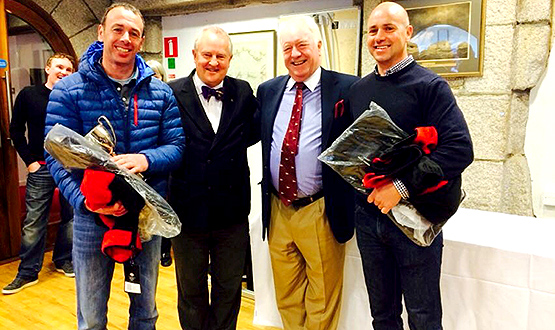
RS400 Winners (from left) Gareth Flanagan with Commodore Justin McKenna vice–Commodore Mike Pomeroy and David Fletcher
On day two it was Espey and Gunning who showed they mean business with a 3, 2 putting them slightly ahead of the two MBSC boats vying for the title, but it was not to be and after carding a tenth that they had to carry, they dropped off the podium and had to settle for fourth place. Bob said afterwards, “Once you find yourself in the pack it’s very hard to fight back”.
Flannigan and Fletcher are a class act and signed off with a second place to finish a sublime regatta and are 2016 Eastern Champions.
Alex and Byrne were second and John and Sandy took 3rd place this time out.
Chris Penny and Simon Martin had a superb regatta and finished on a high with a win in race six and fifth place overall.
So the early season honours and silverware have headed north with Flannigan and Fletcher, the other top teams will want to ensure they don’t have it all way and successfully pluck the Northern trophy from their grasp next time out.
RS Feva Report (By Elaine Malcolm)

RS Feva Winners Henry Start and Morgan Devine with their competitors
In order to encourage the newer members of the RS Feva class this year, the Eastern’s were sailed on a separate course inside Dun Laoghaire harbour. The 11 boat fleet, under the capable race officer Michael Tyrrell and his team, had 8 races over the two days.
Local RstGYC sailors Henry Start and Morgan Devine were to master the conditions and win the event. They were challenged all the way by newcomers to the class, Tim Norwood and Finn Cleary from RIYC. The pair had stolen a march, winning three of the four races in light winds on Saturday.
Third place went to Marcus O’Leary and Jeff McGovern who just edged out the all-girl crew of Emily Arrowsmith and Caira Little. Malahide brothers Liam and Aidan Donnelly carded three third places on Sunday, showing their potential going forward.
Thanks go to our coaches at the weekend Pheobe Norwood and Meg Tyrrell, who provided plenty of encouragement all weekend. Congratulations to all who competed in the RS Feva Easterns.
RS 200 Report
11 RS200s turned out for the first event of the year, the fleet was more of a “mature” crowd, with lots of couple’s combos. This is an area of huge growth in the fleet, and should marry well with the younger contingent who often miss this event due to study commitments.
One of the new faces in the RS200 was multiple fleet dinghy and keelboat champion Neil Spain, who is sailing with his wife Maeve. Another top sailor out there was Women’s match racing star Mary O’Loughlin, joined by past Irish Olympic flag bearer Ciara Peelo as crew. Unsurprisingly they proved to be very competitive. We were also really pleased to have teams up from Caullan Sailing club, which has a very strong local fleet or RS200s.

RS200 Winners Marty O’Leary and Rachel Williamson
On Saturday the fleet enjoyed 3 sharp 48 minutes races on the W/L course. Marty O’ Leary and Racehel Williamson showed their considerable pedigree. Marty was not distracted by being heavily involved in the organisation of the weekend for all classes. The pair put their stall out early and led overnight, to give themselves every chance of defending the title of which they were the holders.
It was very close from 2nd to 5th, with a point separating each team after day 1. Our former RS Fleet chairman Frank O’Rourke (GSC), sailing with college team racer Lisa Smith were the top challengers overnight.
So onto day two and the final 3 races of the championship. Sunday involved more breeze and even tighter racing as teams started to get more aggressive and accurate on the start line. O’Loughlin and Peelo seemed to think they were allowed to start before the competition, but were being a little too keen on two occasions and were duly recalled by the race management in races 4, and 5.
Craig and Cooney from the RStGYC showed some excellent pace and moved themselves up into 2nd overall going into the final race. They were not to go all the way however as the event was already signed sealed and delivered with one to go. Greystones O’Leary and Williamson had delivered another excellent performance which is the norm for this very talented pair who defend their title and remain RS200 Eastern Champions for 2016.
O’Loughlin and Peelo finally decided to start with everyone else in race six. This proved to be a very solid strategy as they have plenty of pace and lead the final race from start to finish. Frank and Lisa worked hard and managed to claw back 2nd place, leaving Craig and Cooney to take bronze a point ahead of the Spains.
See you all at the next event.
The KBC Laser Radial Worlds (Youth and Men’s 2016 World Championships) was launched at a special event in Dún Laoghaire Harbour Company’s historic Harbour Lodge today. This is the first time Ireland will host this sailing World Championship which, according to Eithne Scott-Lennon, Chairperson, Dún Laoghaire Harbour Company “will showcase Dún Laoghaire Harbour on the international sailing stage”. Up to 400 competitors from more than 35 nations will compete in this World Championship Series which will generate €2.5m for the local economy.
KBC Bank Ireland is the title sponsor of this prestigious sailing event which takes place in Dún Laoghaire harbour from 23rd to 30th July and will be hosted by The Royal St. George Yacht Club and Dún Laoghaire Harbour Company. The event is supported by Dun Laoghaire Rathdown County Council and Fáilte Ireland.
Eithne Scott-Lennon, Chairperson, Dun Laoghaire Harbour Company said, “This summer Dún Laoghaire Harbour will be the first Irish host of the eagerly awaited KBC Laser Radial Youth & Men’s World Championships. The Harbour Company along with the Dún Laoghaire Yacht Clubs formed a small group in 2013 to promote the harbour as a location for International Sailing Events. We are delighted that the 2016 ‘KBC Laser Radial Worlds’ is a direct result of that initiative.”
Patt Watt, Director of Retail Distribution, KBC Bank Ireland said, “As Ireland’s newest retail bank we are delighted to sponsor this world-class sailing event. Our sponsorship acknowledges our commitment to supporting community and youth initiatives and recognises the hard work and dedication that is involved by everyone concerned in hosting this event. We wish everyone every success and look forward to being part of a great sporting occasion next July.”
David Kelly, Chairman of the KBC Laser Radial Worlds said, “This is a significant achievement and an exciting milestone in the sailing history of Dún Laoghaire. Apart from the financial benefits locally, it is a unique opportunity to showcase our beautiful harbour and everything Dún Laoghaire has to offer. We are looking forward to some top-class sailing and to welcoming all our competitors from all over the world.”
1,000 supporters and volunteers will be involved in helping to host the KBC Laser Radial Worlds. Over the past number of years Dún Laoghaire has played host to some of the most prestigious European & World Sailing Championships including the Youth Sailing World Championships in 2012.
KBC Bank Ireland has announced its title sponsorship of the ‘Laser Radial Youth and Men’s World Championships 2016’. This is the first time this sailing World Championship will be hosted by Ireland and supported by KBC Bank.
The 2016 ‘KBC Laser Radial Worlds’ will be held in Dún Laoghaire harbour from 23rd to 30th July 2016. Up to 400 competitors from more than 35 nations will compete in the World Championship series supported by over 1,000 supporters and volunteers from the local area. The event is expected to generate approximately €2.5m for the local economy.
Aidan Power, Director of Customer, Brand and Marketing at KBC Bank Ireland said, “KBC Bank is delighted to announce our title sponsorship of this world-class championship sailing event in Dún Laoghaire. As Ireland’s newest retail bank, we are passionate about the communities we live and work in and our sponsorship celebrates Dún Laoghaire’s vibrant sailing community on the international stage. It’s an exciting event that will showcase the skill and determination of the competitors, and KBC’s commitment to supporting community and youth initiatives. We look forward to a fantastic week for all involved”.
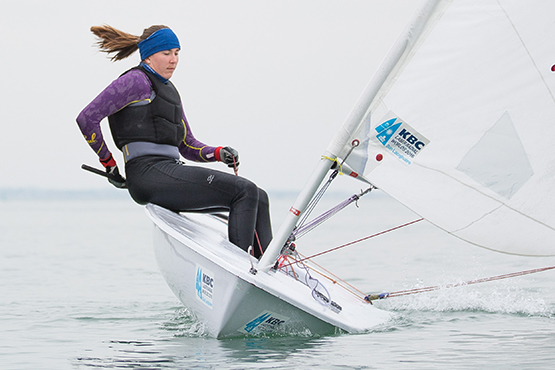
Olympic Sailor, Annalise Murphy at the announcement of the KBC Laser Radial Worlds 2016 in her home port of Dun Laoghaire. Photo: Naoise Culhane
Welcoming KBC Bank Ireland’s involvement David Kelly, Chairman of the Laser Radial Worlds 2016 said, “We are delighted that KBC has come on board as title sponsor of this event. It is a significant achievement to be awarded the opportunity to host these Laser World Championships – it is a first for Ireland and we sincerely thank KBC for their support. Our goal is to make this event a successful and memorable occasion for competitors, volunteers and the local community in Dún Laoghaire”.
The ‘KBC Laser Radial Worlds’ are being hosted by The Royal St. George Yacht Club and Dún Laoghaire Harbour Company, supported by Dun Laoghaire Rathdown County Council and Fáilte Ireland. Ireland follows in the footsteps of Canada in 2015 and Poland in 2014 to host this prestigious event.
The Royal St. George Yacht Club hosted the Leinster Schools Team Racing Championships in Dun Laoghaire Harbour last Tuesday. In glorious sunshine 8 teams completed 31 races to provide a result.
The Round Robin was tightly fought, with a 3 way tie between Loreto St. Stephens Green, Loreto Dalkey and St. Conleths, with Loreto St. Stephens Green coming out on top after a count back on points to break the tie.
In the finals it was Gonzaga versus Kilkenny and this went to the wire, with both teams having a win each. Now we were down to a nail biting 3rd race in which Gonzaga took the spoils. This was the second time running that Gonzaga have won the Leinster Schools Trophy. Commiserations to Kilkenny who gave Gonzaga quite a challenge.
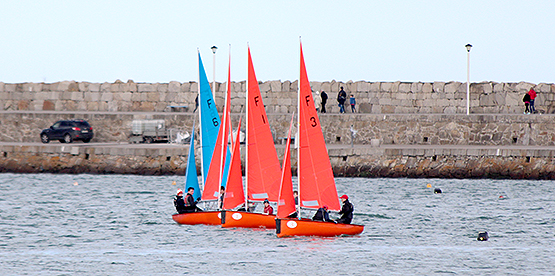
Leinster Schools Team Racing action at Dun Laoghaire
The top four teams qualify for the Irish Schools Team Racing Championships which will be hosted at the F.O.M.E.C. sailing centre in Schull on the 9th & 10th of April.
Adam Hyland (R.S.G.Y.C.) was the Race Officer and did an excellent job of completing the event, with a number of wind shifts throughout the day. Ailbe Millerick was the Chief Umpire and was assisted by Dave Sheahan.
Thank you to everyone who assisted in the organising and running of the event.
All the competitors deserve acknowledgement for the lovely manner in which they conducted themselves both on and off the water throughout the event.
The final results were as follows:
1st Gonzaga College
2nd Kilkenny
3rd Loreto St. Stephens Green (Tie Break 20 Points)
4th Loreto Dalkey (Tie Break 21 Points)
5th St. Conleths (Tie Break 22 Points)
6th St. Andrews 1
7th Belvedere College
8th St. Andrews 2
New Group Wants To Reclaim Irish Sailing For The Republic
The recently-formed maritime association SOAR (Sailors Of A Republic), which claims to have a nationwide membership, today outlines its plans to reclaim the yacht and sailing clubs of Ireland into a truly republican spirit.
“In view of the successful and generally peaceful nature of the Easter Rising celebrations this week,” a spokesman told Afloat.ie, “we feel the opportunity has been provided to reveal how we will give Irish sailing organisations a completely new image in keeping with the re-born spirit of the times.”
“We would point out” the spokesman continued, “that when the Water Club of the Harbour of Cork was founded in 1720, despite the connections to English royals of some of the founding members, there was none of this royalty nonsense in the title of the new club. And it cannot be claimed that there was no precedent for such a thing. Several scientists – who were to include Robert Boyle of Cork – had got together to found the Society for Improving Natural Knowledge in November 1660, and it very quickly was given the title of the Royal Society.”
“Yet even through its quieter years on Cork Harbour in the late 1700s, the pioneering group of sailors in Cork was always proud to be known simply as the Water Club. It was only many years after the last of the original founders had died that the club contemplated re-titling itself, and it was in the beginning of the era of new yacht club formations in the early 1800s that it allowed itself to become the Royal Cork Yacht Club”.
“At its most simple” the SOAR spokesman said, “what we are seeking is a re-branding exercise. But we are mindful of the recent public annoyance caused by the re-branding of Eircom as Eir, which cost something in the region of €16 million. Thus our special SOAR Nomenclature Sub-Committee has been looking at ways of minimising the cost of a changeover, particularly as it could mean Ireland’s royal yacht clubs would feel they are being discriminated against.”
“Their boat owners would understandably have a special grievance if badly thought-out recommendations put them to extra expense in changing the initials of their club on the transoms of their boats.
But fortunately the words “royal” and “republic” both begin with the letter “R”. So with some foresight, the only expense would be in the detail of club letterheads, in-house notices and so forth, which we fell the truly republican-minded sailors of Ireland will be happy to bear as a group”.
“In order to ensure there is no unnecessary change in the lettering of club initials on boats, our Committee have decided that the Royal Irish Yacht Club will become the Republic of Ireland Yacht Club, or alternatively the Real Ireland Yacht Club. As for the Royal St George Yacht Club, it will become the Republican St George YC. And a real flash of imagination is being shown towards the pioneering spirit of south coast sailing - the Royal Cork Yacht Club will in future be known as the Rebel County Yacht Club”.
However, it is understood that there will be one exception to the proposed name changes. Another source has revealed to Afloat.ie that the Royal Western Yacht Club of Ireland in Kilrush will be allowed to keep its current title. “We are of the opinion that County Clare’s links with Brian Boru provide a royal connection to a real Irish king, a connection which long pre-dates any foreign incursions. We are entirely in favour of keeping the royal titles if we can find a link to our own royalty, and in Brian Boru country, that is easily done.”
Glen Class Video Shows 2015 Highlights of Dublin Bay Sailing
The Glen keelboat class video below was made by local sailor Ki Duong in action on Dublin Bay over the 2015 season. Edited in a jump cut fashion it had members of the Glen sailing community up on their feet and dancing when it was premiered at the recent Glen Dinner and prizegiving at the Royal St George Yacht Club.
As the days grow longer, Glen owners minds are turning to the annual refit and launch. After over fifty years of sailing, things are looking good for season 2016 in these classic wooden boats.
Ireland’s Fireball Dinghy Class Provided The Secret Of Eternal Youth
You’ll have glimpsed the photo gallery and heard the reports of the International Fireball Dinghy Class 50th Anniversary Irish Reunion last Saturday night in the Royal St George YC in Dun Laoghaire. Fifty years, by George……Most sailing folk still think of the Fireball as a fresh and unique off-the-wall sailing phenomenon, a crazy European take on the skimming-dish scows of the lakes of America’s mid-West. And we think of these very special racing dinghies as being something as new as tomorrow, ingenious boats for ingenious owners who like to do all sorts of personal tunings and tweaks to their pride-and-joy. So it brings us up short to find them celebrating their Golden Jubilee. W M Nixon gives his own take on the Former Fireball Fanatics.
If you’re from anywhere well outside the bubble which is southeast Dublin, you’ll assume that a group of guys who regularly drink in a place called the Tramyard will be a bunch of winos. But those in the know are well aware that the Tramyard in Dalkey is a more-than-agreeable coffee house where a regular group of morning habituees supping the essence of the sacred bean is a gathering of sailing friends who have been mates since studying in college or whatever they were doing at that exciting time of life, when all things were possible, and just to have an idea was enough to have the energy to implement it and do something with the result.
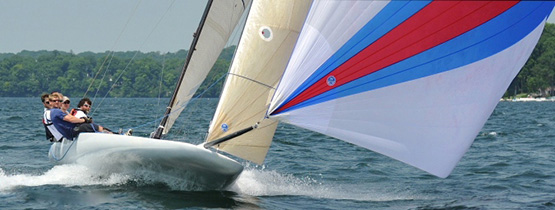
The inspiration for the Fireball design more than fifty years ago came partially from the classic scows of the lakes of mid-western America. This is a Melges Class A Scow.
As this Tramyard crowd have been regularly together for so long, they have not noticed the effects of the passing of the years on each other. So when Derek Jago got to reflecting among them last Autumn that maybe their best sailing years were spent in the Fireball Class, and that it was amazing to think it had been around for fifty years, former Fireball champion Brian Craig immediately suggested that if Derek would organise a post-50th Anniversary Reunion of the Irish Fireball Class past and present, then he – Brian - would see about making the Royal St George Yacht Club available as the venue, for after all it was the George – home club for most of them - which had the biggest Fireball fleet in the great days of the class’s Irish glory.
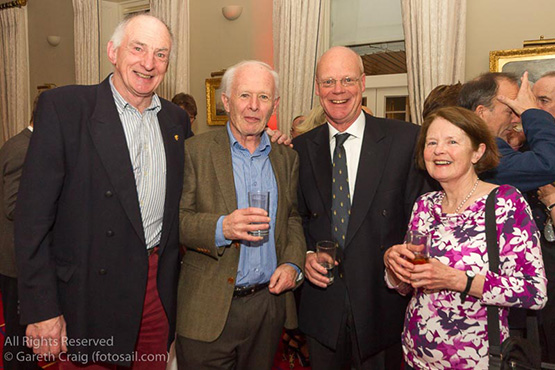
The party happens – Derek Jago (left) with former Fireballers Howard Knott, Peter Stapleton and Hilary Knott. Photo: Fotosail
Of course, when you do organise something like this, you will know what your own close circle of old friends now look like. But it’s a fascinating exercise in the observation of the aging process to wheel in people you mightn’t have seen in thirty and more years.
In fact, it might have been fraught with a certain risk of non-recognition of faces from the distant past. But the Irish Fireball Class was not only an outstanding success in its peak years, it went on to send out rising stars who were to make their mark in many other areas of sailing. Consequently last Saturday night proved to be a gathering of familiar faces of whom, in some cases, folk were saying: “But I never knew you were ever a Fireball sailor”.
Yet not only were they Fireball sailors once upon a time, but they were very proud of the fact. For in the nicest possible way, the Fireball was and is a bit of a cult thing. She was designed by Peter Milne, who at the time of her creation was working on the drawings for the latest Donald Campbell world water speed record challenger. In the midst of such a hothouse of technology and massive expenditure, it seemed like a breath of fresh air to take a little time out to create a boat which reduced sailing to its absolute essentials, and he did it so well that Peter Milne thereafter never quite matched this one divine inspiration.
And it was truly inspirational. After all, who would have thought that a minimalist boat, with just about zero freeboard and skinny with it, and with her slim hull further reduced in volume by having a cut-off pram bow, who could have thought it would be such a superb sailing machine when she’d a crew who gave total commitment to the concept and realized that the use of the trapeze was what Fireball sailing was all about?

The first in Ireland –Roy Dickson’s No 38 making a tentative visit to Dun Laoghaire in September 1962.
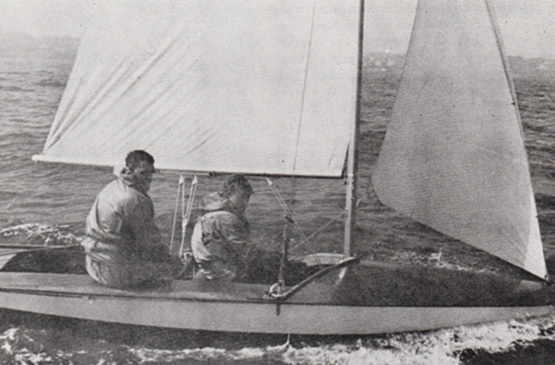
Champions – Roy Dickson crewed by David Lovegrove after successfully defending the Fireball Nationals in 1966.
Well, the first in Ireland was Roy Dickson of Kilbarrack and Sutton on the north shores of Dublin Bay, a man who cannot contemplate any boat without thinking about ways of improving it. He’d already been taking several sails on the wild side by building a Jack Holt-designed 16ft Hornet with a sliding seat in the manner of Uffa Fox’s famous sailing canoes, so when the design of the Fireball first appeared in Yachts & Yachting magazine in 1962, it was a eureka moment.
Roy’s first Fireball, no 38, made a tentative appearance across Dublin Bay in Dun Laoghaire at the end of the 1962 season, and next Spring it was revealed that other sailors from the north shore were following in his footsteps. They’d already set up a class association with Peter O’Brien as Chairman and Eddie Kay as Honorary Secretary, and it was expected that up to 20 Fireballs would be racing in Ireland by the end of the 1963 summer.
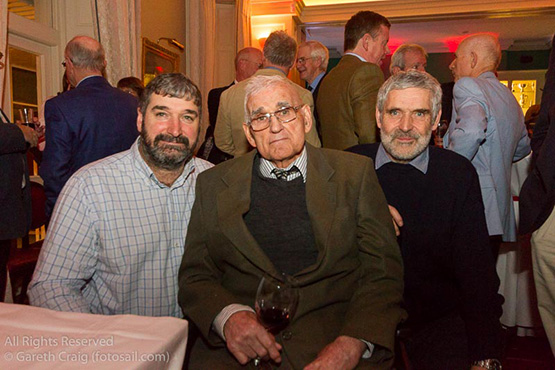
The founding father – Roy Dickson with his sons Ian (left) and David on Saturday night at the celebration of the Irish Fireball Class. Photo: Fotosail
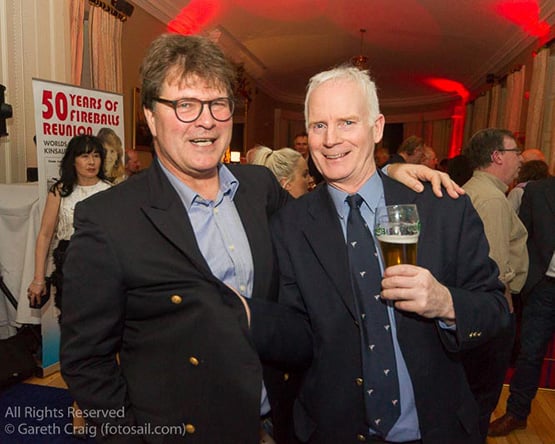
Jan van der Puil (left) with 1995 World Champion John Lavery. Photo: Fotosail

Early days – at an IYA Easter Meeting in Wexford the new Fireballs cut a dash by comparison with the older IDRA 14 and Enterprise in the background. Photo: W M Nixon
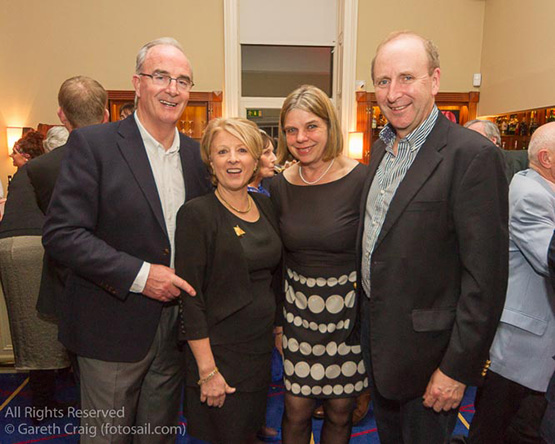
Celebrating the Fireball – Anthony and Sally O’Leary, with Cathy McAleavey and Con Murphy. Photo: Fotosail
It was an extraordinary breakthrough, the memory of it all made even more vibrant by the fact that Roy Dickson himself was there in Dun Laoghaire last Saturday night, his innovative Fireball years recalled as just another chapter in his own fantastic sailing career, which has gone right to the top both inshore and offshore.
The Fireball spoke eloquently to several successive waves of Irish sailors, and in the period between the mid 1960s and the late 1990s, you’d be hard put to say just what was the key year, with an early dose of extreme excitement being the Fireball Worlds at Fenit on Tralee Bay in 1970, John Caig from England being the winner. For although an unmatched high was reached in 1995 when John Lavery and David O’Brien of the National YC won both the Europeans and the Worlds in a mega regatta staged by their home club on Dublin Bay, at other times Adrian and Maeve Bell from the north – they were with Lough Neagh SC at the time - were very much in the international frame, counting many major titles.

Fireballs on an early outing to Sligo, where the Worlds were staged in 2011.
As for staging Fireball World Championships, Ireland has stepped up to the plate four times, with a particularly epic Worlds in Kinsale in 1977 where the Godkin brothers set the pace in the local fleet. Then there was the glorious home win at Dun Laoghaire in 1995. And the most recent Worlds in Ireland were at Sligo in 2011, where the great Gus Henry may have been best known as a stalwart of the GP 14 Class, but he too is a top sailor who savoured the Fireball experience.
At the height of the class’s popularity, nearly three quarters of the boats in Ireland were said to be an own-build, and Roy Dickson was the pace-setter in innovation. It’s said that if Roy turned up at a major international regatta with some completely new but barely perceptible additional feature on his boat, by the next championship you could be reasonably sure that at least half the fleet would have copied him.
But for some years now the class has seen plastic boats in the ascendant, which restrains the innovators. And numbers in Ireland are admittedly no longer so spectacular, for in its top years the truly active Fireball fleet here numbered 70 boats, which for an out-and-out performance dinghy was quite something.

There’s still as little bulk to the boat as possible, but they’re now built in GRP, as seen here with Frank Miller's boat at the Volvo Dun Laoghaire Regatta. Photo: VDLR
Yet while the fleets are reduced, the memories if anything are stronger than ever. The photos reveal the calibre of the people who were and are involved in Fireball racing in Ireland – it’s a national Who’s Who of sport afloat. And if that weren’t enough, the roll call of those who preceded John Lavery and David O’Brien in the intense battles to win the World Championship is of truly global stature in international sailing.
The first one of all in 1966 was Bob Fisher, no less, crewed by Richard Beales. Then Steve Benjamin of the US was in fine form in the 1970s, as he won in ’76 and then defended successfully at Kinsale in 1977. But in 1978 at Pattaya in Thailand, a new name came centre stage – the one and only Lawrie Smith. Then in 1981 the Worlds winner was future top dinghy designer Phil Morrison, with Fireball mods and tuning worthy of Roy Dickson.
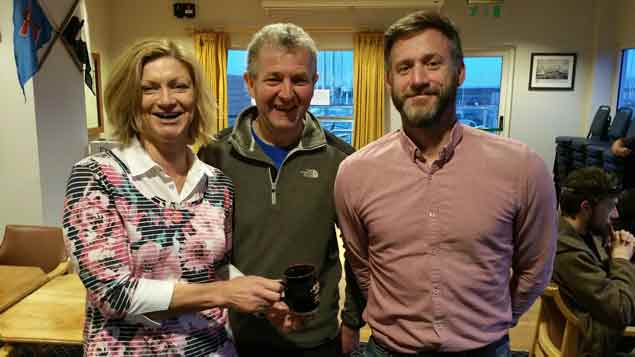
Current Irish Fireball Class Chairperson, seen speaking at last Saturday’s party, is Marie J Barry. Photo: Fotosail
In 1994 it was ace sailmaker and multi-champion Ian Pinnell who won the Fireball Worlds, and this set the bar high for John Lavery and David O’Brien in Dublin Bay in 1995. Faced with the challenge, they implemented a rigorous two-year training and competition programme in the countdown to the big one, and it all came out as planned.
As the Fireball Worlds 1995 were staged in September, the rest of the Irish sailing community were well home from holidays and back at the day job, so those driving home from work on the Friday night heard it on the car radio as one of the top stories on the evening sports news. Ireland had won a world title. Better still, it was in sailing too. And it was on the peaktime national news. It was a moment to be recalled and savoured many times in Dun Laoghaire last Saturday night.

We can always use a cover like this – welcome news with David O’Brien and John Lavery from the Sept/Oct 1995 Afloat.
See full Fireball 50th photo gallery by Gareth Craig of Fotosail here




























